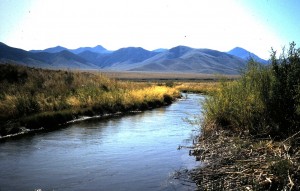Birch Creek
It is now timely to give this great little stream some attention. That attention is appropriate for several reasons. Access, proximity, reliably aggressive wild trout, put and take fishing, reasonable solitude, and natural beauty are some. Also Birch Creek is ready for fishing right now. From the Snake River Plain this creek is about an hour and a half drive at the most over good highways. Little traffic can be expected going and returning from it. Believe it or not, Birch Creek is a spring creek in that it originates mostly from springs in the Kaufman area. From here it becomes a small but classic desert stream. Below Lone Pine resort Birch Creek flows mostly through public land, and it is here where weekenders congregate to fish, camp, and ride. Thus IDF&G generously supplements the wild fish population here with hatchery catchables. The result is that the wild fish mostly move out to the diversion below to escape piscatorial crowding and human hub-bub. For sure one can encounter good fishing here, but usually under less tranquil conditions. If one travels upstream past Lone Pine, Birch Creek is to the left and on private land. But this land is under agreement for public access and as such is designated a “family fishing area” through the generosity of its owner. Signs at either end and the middle proclaim this. Access here is walk-in with distances from parking varying upwards from a bit less than one hundred yards. Fencing limits intrusion by cattle, so degradation is minor. The stream in the upper end of the area runs through broken willow patches with undercuts and surprisingly deep holes and runs. Throughout the area one can see superb in-stream gravel beds that host aquatic insects as well as offering spawning locations. Rainbow and brook trout, introduced many years ago, inhabit the creek in good numbers. No need to supplement trout populations here! This is high country, so it takes a while for Birch Creek to regain heat lost through radiation at nighttime and early light. That means aquatic insects become most active around mid day, and the same goes for the resident ‘bows and brookies. So if you intend to fish here, enjoy a hearty breakfast and leisurely drive to arrive about then. Hip waders are all that is necessary to walk around the creek in the family area, and during the heat of summer, wet wading is not out of the question. I have a two-weight rod which is ideal for small streams, Birch Creek included. I use a floating line and nine-foot leader tapered to 5x, and I have a ball catching brookies and bows ranging upward to a rare sixteen inches. They are full of fight and eager as can be. This time of year caddis, midge, isoperla, and BWO life cycle patterns work. So do traditional attractors in small sizes. A few golden stoneflies are also present. As summer comes on any traditional terrestrial pattern works well.
Experience tells me that large rivers tend to intimidate entry level fly-fishers. Small streams are almost like a laboratory situation where all things are in a smaller scope and more easily observed. That means small water is more quickly understood with respect to realizing where fish hold within, where they move to feed, and where they seek cover. Essentially all these are more “concentrated” in a small water siting. It also seems that trout in smaller waters are inherently more aggressive when feeding is considered. This results in a consistency in feeding that larger waters do not always offer. It follows from this that the fly-fisher will have more chances per given amount of time to learn how to respond to feeding fish. Thus it is to a small stream that I take or recommend to a rank beginner, and Birch Creek is one of the best for this purpose. Afterwards it is up to that person to take lessons learned to be sharpened and expanded on through fishing larger waters.

